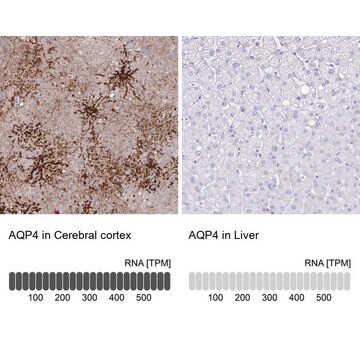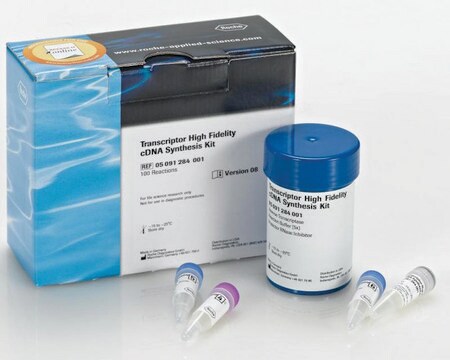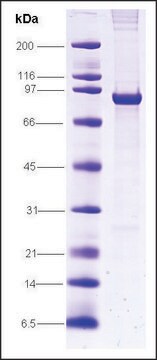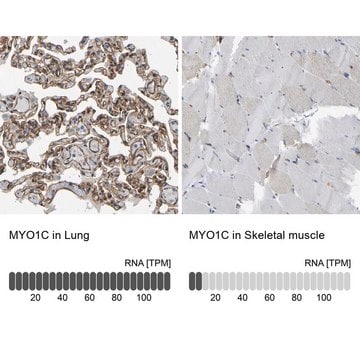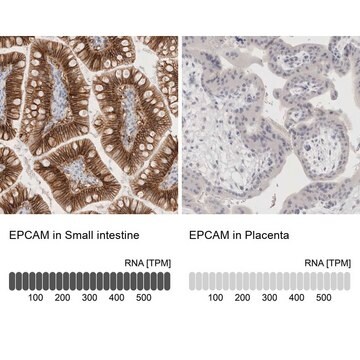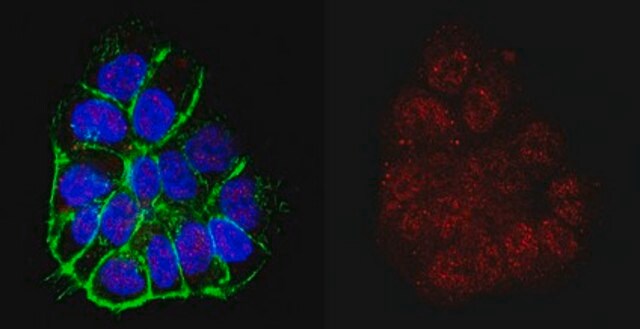MABS1221
Anti-GLEPP1/PTPRO Antibody, clone 5C11
clone 5C11, from mouse
동의어(들):
Receptor-type tyrosine-protein phosphatase O, Glomerular epithelial protein 1, Osteoclastic transmembrane protein-tyrosine phosphatase, Protein tyrosine phosphatase U2, PTP-OC, PTP phi, PTP-U2, PTPase U2, R-PTP-O
로그인조직 및 계약 가격 보기
모든 사진(1)
About This Item
UNSPSC 코드:
12352203
eCl@ss:
32160702
NACRES:
NA.41
추천 제품
생물학적 소스
mouse
Quality Level
항체 형태
purified antibody
항체 생산 유형
primary antibodies
클론
5C11, monoclonal
종 반응성
human
반응하면 안 됨
mouse, rat, rabbit
기술
electron microscopy: suitable
immunofluorescence: suitable
immunohistochemistry: suitable
동형
IgG2bκ
NCBI 수납 번호
UniProt 수납 번호
배송 상태
wet ice
타겟 번역 후 변형
unmodified
유전자 정보
human ... PTPRO(5800)
일반 설명
Receptor-type tyrosine-protein phosphatase O (EC 3.1.3.48; UniProt Q16827; also known as Glomerular epithelial protein 1, Osteoclastic transmembrane protein-tyrosine phosphatase, Protein tyrosine phosphatase U2, PTP-OC, PTP phi, PTP-U2, PTPase U2, R-PTP-O) is encoded by the PTPRO (also known as GLEPP1, NPHS6, PTPROT, PTPU2) gene (Gene ID 5800) in human. Podocytes are complex neuron-like post-mitotic cells adherent to the underlying glomerular basement membrane via foot processes that must contiguously cover the filtration surface area to maintain the normal filtration barrier. Glomerular epithelial protein 1 (GLEPP1) is a podocyte receptor membrane protein tyrosine phosphatase located on the apical cell membrane of visceral glomerular epithelial cell (VGEC) foot processes and is commonly used as a podocyte marker for assessing podocyte density. Altered GLEPP1 staining patterns are reported in kidney sections from individuals with congenital nephrotic syndrome of the Finnish type (CNF), minimal-change nephropathy (MCN), and Hodgkin’s disease. GLEPP1 is initially produced with a signal peptide sequence (a.a. 1-29), the removal of which yields the mature protein with a large extracellular region (a.a. 30-822), followed by a transmembrane segment (a.a. 823-843) and a cytoplasmic domain (a.a. 844-1216).
특이성
Clone 5C11 recognizes GLEPP1 (PTPRO) in human podocytes and neurons, but not GLEPP1 spliced isoforms lacking Fibronectin type-III domains 1-5 in their extracellular region in many other cells. Clone 5C11 detected a 200 kD protein band in glomerular extracts by Western blotting under both reducing and nonreducing conditions and immunostained only visceral glomerular epithelial cell (VGEC) in human renal cortex tissues by both fluorescent and non-fluorescent immunohistochemistry (Sharif, K., et al. (1998). Exp. Nephrol. 6(3):234-244).
면역원
Epitope: Fibronectin type-III domains 1-5.
GST-tagged recombinant fragment corresponding to the Fibronectin type-III domains 1-5 of human GLEPP1/PTPRO.
애플리케이션
Detect GLEPP1/PTPRO using this Anti-GLEPP1/PTPRO Antibody, clone 5C11 validated for use in Immunohistochemistry, Immunofluorescence, Electron Microscopy.
Immunohistochemistry Analysis: A representative lot detected a loss of GLEPP1 immunoreactivity as a measure of podocyte density reduction (podocyte depletion) in kidney tissues with transplant glomerulopathy using formalin-fixed, paraffin-embedded kidney sections (Yang, Y., et al. (2015). J. Am. Soc. Nephrol. 26(6):1450-1465).
Immunofluorescence Analysis: Prior to purification, clone 5C11 hybridoma culture supernatant detected GLEPP1 (PTPRO) immunoreactivity predominantly on visceral glomerular epithelial cell (VGEC) foot processes along the glomerulus (GBM) in manthanol-fixed, adult human kidney cryosections, while altered GLEPP1 staining patterns were seen in kidney sections from individuals with congenital nephrotic syndrome of the Finnish type (CNF), minimal-change nephropathy (MCN), or Hodgkin’s disease (Sharif, K., et al. (1998). Exp. Nephrol. 6(3):234-244).
Electron Microscopy Analysis: Prior to purification, clone 5C11 hybridoma culture supernatant detected GLEPP1 (PTPRO) immunoreactivity at the apical aspect of the foot processes and the cell membrane of larger processes in paraformaldehyde-fixed, paraffin-embedded normal human adult kidney sections, while GLEPP1 immunoreactivity was seen redistributed from glomerulus (GBM) on the apical cell membrane of VGECs to microvilli on kidney sections from individuals with congenital nephrotic syndrome of the Finnish type (CNF) or minimal-change nephropathy (MCN) (Sharif, K., et al. (1998). Exp. Nephrol. 6(3):234-244).
Immunofluorescence Analysis: Prior to purification, clone 5C11 hybridoma culture supernatant detected GLEPP1 (PTPRO) immunoreactivity predominantly on visceral glomerular epithelial cell (VGEC) foot processes along the glomerulus (GBM) in manthanol-fixed, adult human kidney cryosections, while altered GLEPP1 staining patterns were seen in kidney sections from individuals with congenital nephrotic syndrome of the Finnish type (CNF), minimal-change nephropathy (MCN), or Hodgkin’s disease (Sharif, K., et al. (1998). Exp. Nephrol. 6(3):234-244).
Electron Microscopy Analysis: Prior to purification, clone 5C11 hybridoma culture supernatant detected GLEPP1 (PTPRO) immunoreactivity at the apical aspect of the foot processes and the cell membrane of larger processes in paraformaldehyde-fixed, paraffin-embedded normal human adult kidney sections, while GLEPP1 immunoreactivity was seen redistributed from glomerulus (GBM) on the apical cell membrane of VGECs to microvilli on kidney sections from individuals with congenital nephrotic syndrome of the Finnish type (CNF) or minimal-change nephropathy (MCN) (Sharif, K., et al. (1998). Exp. Nephrol. 6(3):234-244).
품질
Evaluated by Immunohistochemistry in human kidney tissue.
Immunohistochemistry Analysis: A 1:50 dilution of this antibody detected GLEPP1/PTPRO in human kidney tissue.
Immunohistochemistry Analysis: A 1:50 dilution of this antibody detected GLEPP1/PTPRO in human kidney tissue.
표적 설명
200 kDa calculated.
물리적 형태
Format: Purified
기타 정보
Concentration: Please refer to lot specific datasheet.
적합한 제품을 찾을 수 없으신가요?
당사의 제품 선택기 도구.을(를) 시도해 보세요.
Storage Class Code
12 - Non Combustible Liquids
WGK
WGK 1
Flash Point (°F)
Not applicable
Flash Point (°C)
Not applicable
시험 성적서(COA)
제품의 로트/배치 번호를 입력하여 시험 성적서(COA)을 검색하십시오. 로트 및 배치 번호는 제품 라벨에 있는 ‘로트’ 또는 ‘배치’라는 용어 뒤에서 찾을 수 있습니다.
Kathryn E Haley et al.
Frontiers in physiology, 12, 625762-625762 (2021-08-03)
Podocyte loss plays a pivotal role in the pathogenesis of glomerular disease. However, the mechanisms underlying podocyte damage and loss remain poorly understood. Although detachment of viable cells has been documented in experimental Diabetic Nephropathy, correlations between reduced podocyte density
Extracellular Matrix Injury of Kidney Allografts in Antibody-Mediated Rejection: A Proteomics Study.
Sergi Clotet-Freixas et al.
Journal of the American Society of Nephrology : JASN, 31(11), 2705-2724 (2020-09-10)
Antibody-mediated rejection (AMR) accounts for >50% of kidney allograft loss. Donor-specific antibodies (DSA) against HLA and non-HLA antigens in the glomeruli and the tubulointerstitium cause AMR while inflammatory cytokines such as TNFα trigger graft injury. The mechanisms governing cell-specific injury
자사의 과학자팀은 생명 과학, 재료 과학, 화학 합성, 크로마토그래피, 분석 및 기타 많은 영역을 포함한 모든 과학 분야에 경험이 있습니다..
고객지원팀으로 연락바랍니다.
